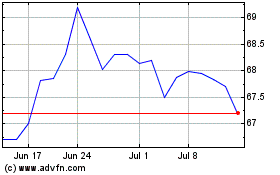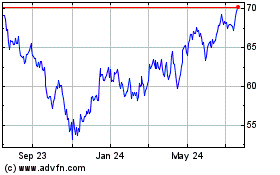Real-Estate Companies Amass Cheaper -- but Riskier -- Short-Term Debt
July 09 2019 - 9:52AM
Dow Jones News
By Konrad Putzier
More publicly-listed real-estate companies are taking on
short-term debt, assuming additional risk to reduce their borrowing
costs.
This debt, known as commercial paper, can have terms as short as
a single night. It is a popular tool for many companies to cover
accounts payable or pay for inventory.
Real-estate investment trusts tend not to have these expenses,
but some property firms are amassing short-term obligations because
they can borrow at cheaper rates than longer-term debt. Interest
rates on commercial paper are generally a half percentage point
lower than those on bank credit facilities, according to a new
report from Fitch Ratings.
The risk, analysts say, is that property companies could be
unable to refinance this debt if lenders suddenly lose confidence,
for example in the event of a financial panic.
Because real estate can take time to sell and prices fluctuate,
property owners faced with a sudden financing shortfall are
sometimes forced into foreclosure -- one of the reasons most firms
prefer long-term mortgages.
"It would be an unforced error if there were a hiccup in the
commercial-paper availability," said Stephen Boyd, a senior
director at Fitch. "Why take that risk?"
Mr. Boyd said more REITs are issuing short-term debt in part
because the real-estate market cycle is nearing its end. "There are
fewer levers to pull off earnings growth, and this is one of them,"
he said.
While commercial paper accounts for a mere fraction of overall
real estate liabilities and the practice is not widespread, some
prominent property companies are getting involved.
In the first half of this year, Ventas Inc., Welltower Inc. and
Mid-America Apartment Communities Inc. issued commercial paper.
Ventas's vice president of investor relations, Juan Sanabria, said
commercial paper is "funding short term working capital needs and
is not a mismatch to long duration assets."
Apartment owner Equity Residential has been issuing this type of
debt since February 2015 and had $345 million outstanding at the
end of the first quarter, according to its public filings. Chief
Financial Officer Robert Garechana said the company decided to
issue commercial paper because "it just was a cheaper alternative"
to credit facilities.
It uses its $500-million program to cover short-term funding
gaps, for example between the expiration of a mortgage and the
issuance of new long-term debt, or between the purchase of one
building and the sale of another.
Mr. Garechana said he fielded questions from bond investors
about the risks of commercial paper, but most weren't concerned. He
said the company has a $2 billion credit facility, and keeps $500
million unused in case it needs to end its commercial-paper
program. "When you use it in a modest way like we do, I don't view
it as being incrementally risky, " he said.
Mall owner Simon Property Group Inc. issued its first commercial
paper in October 2014 under a program that allowed the company to
borrow up to $500 million.
The company has since increased the program to $2 billion, and
had $1.3 billion outstanding at the end of March, according to
Fitch. The weighted average interest rate on its commercial paper
was 2.58%, compared with 3.28% for its credit facilities, according
to its public filings. Simon Property didn't respond to requests
for comment.
In most cases, commercial paper accounts for less than 5% of
debt. And property firms usually have credit facilities with banks
that they could tap into if short-term debt is no longer
available.
Still, the Fitch report called commercial paper issuance a
"modest net credit-negative" for real-estate investment trusts.
While the availability of credit facilities lessens the risk, the
report notes, it doesn't eliminate it.
Using bank facilities to pay off commercial paper could mean
less money is available to use elsewhere, and concerns over
short-term debt could spill over into bond and mortgage markets,
leading to higher debt costs there as well.
Write to Konrad Putzier at konrad.putzier@wsj.com
(END) Dow Jones Newswires
July 09, 2019 09:37 ET (13:37 GMT)
Copyright (c) 2019 Dow Jones & Company, Inc.
Equity Residential (NYSE:EQR)
Historical Stock Chart
From Mar 2024 to Apr 2024

Equity Residential (NYSE:EQR)
Historical Stock Chart
From Apr 2023 to Apr 2024
